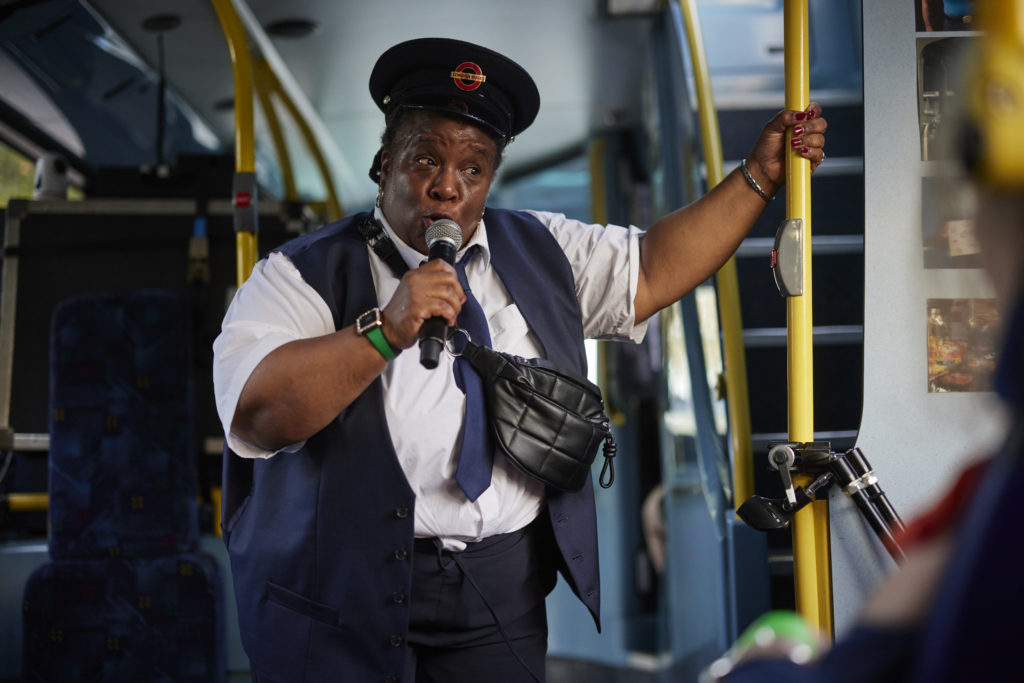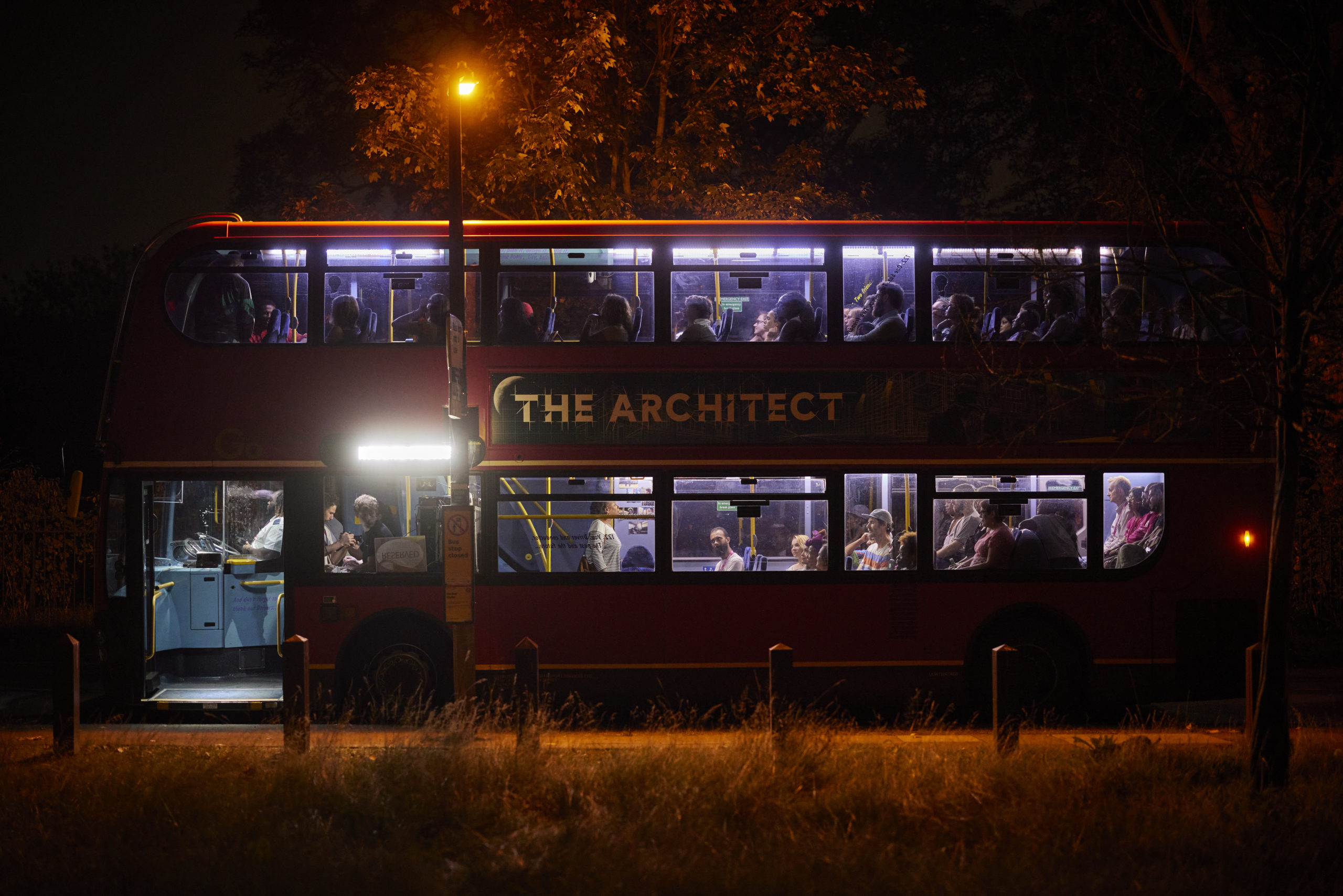The Architect – Actors Touring Company and Greenwich + Docklands International Festival
A truly unique theatrical performance, The Architect takes me on a nostalgic trip through South East London before delivering an emotional climax open to all.

The Architect
In another first for the Salterton Arts Review, I have never been to a theatrical performance that takes place on a moving bus. But such is The Architect, an Actors Touring Company and Greenwich + Docklands International Festival (GDIF) co-production. If you recall I did actually see another work by the Actors Touring Company at GDIF a couple of years back: Family Tree. This promenade performance told the story of Henrietta Lacks and her immortal cells. The Architect is a little closer to home.
So close, in fact, that it takes place on a South East London bus route: the 122 from Crystal Palace to Plumstead. Although our special bus meanders a little from the usual route, around Kidbrooke and Eltham. We start the experience near Deptford Creek, gaining wristbands and watching a little pre-show entertainment in the form of two boisterous boys waiting for the bus (played by Omar Austin and Dalumuzi Moyo). While one of them answers the call of nature, the bus arrives and we are greeted by our conductor (Llewella Gideon). Then we climb aboard and set off on our journey.
As our journey progresses, the structure becomes clear. As we make stops along our route, actors board and alight, playing out scenes for those on the lower and upper decks. We see a young couple, a pregnant woman and her niece, a mother, those boys (when they finally catch up with the bus) and a love interest for one of them. The talented actors sometimes take on more than one of these parts, making it a compact cast.

Imagining A Different World
The story that unfolds is a semi-linear one about the raising of Black boys. Early scenes are full of potential: fears for the future but with a lot of love and hope. We can trace the narrative from the onset of labour to the teenage years discussing girls and career paths to a now successful grown up man, Asher: an architect who should call his mother more. The characters discuss the difficulty of choosing a name for a boy who must stand out yet blend in, the way it takes a village to raise children and keep them safe, and the fact that you can’t fight for a future if you can’t imagine it.
We alight the bus in General Gordon Square in the heart of Woolwich. The ticketed section of the performance is over. We now follow the Architect (Karl Collins) to a conclusion which is free and open to all. Asher takes the stage amidst a steel pan band. The Architect’s Dream is his impassioned vision for the future. A new way of living that centres community and embraces everyone. And finally, an image flashes up on screen. A map of this part of London overlaid with a familiar image of Stephen Lawrence. Did you pick up the clues: a Black teenager in South East London, who wants to be an architect, heading home on the bus? I had not fully joined the dots, so for me it was a powerful moment, reframing everything in an instant.
Not that it’s a secret, it is in fact very much the intention. The Architect commemorates 30 years since Lawrence’s death. An artistic response which calls on us to come together and celebrate Black lives and find hope in sorrow. My preference for reading up after the fact and letting emotions guide me during a performance just didn’t prepare me on this occasion for what was to come.

Staging Unique Theatre
As well as the emotional impact, the logistics of The Architect are very impressive. To have a performance that runs this smoothly when you have to pick up and drop off actors at the right locations, manage traffic, drive alongside the Cambridge Harriers (Lawrence’s running club) for a time, and replay scenes for the different sections of the audience is no mean feat. There are also audio elements to incorporate. A couple of scenes are played as voice-overs. Including, notably, an uncomfortable racist monologue which director Matthew Xia lets us stew in for a while. Not being able to clearly hear all of the audio elements was one of the few weaker spots, but also reminded me of many experiences on actual London buses.
The writing is also unusually decentralised. The Architect is conceived by Mojisola Adebayo, Roy Williams and Matthew Xia, but each scene is written by one of five writers. For this reason the character of the Conductor, who serves as the bridge between different characters and the audience, works particularly well. The whole thing comes together into an immersive, innovative and emotionally impactful whole.
Finally, in an interesting turn of events, I actually caught the real 122 back home again. The Urban Geographer and I used to catch it all the time when his sister lived in Woolwich. I just never knew the significance of that route, or the stop on Well Hall Road where Stephen Lawrence and Duwayne Brooks waited for a bus. A timely reminder of the importance of the arts as keepers and explorers of our collective memory.
Salterton Arts Review’s rating: 4/5
The Architect on until 10 September, ticketed
The Architect’s Dream also until 10 September, free to all (see here for details)
Trending
If you see this after your page is loaded completely, leafletJS files are missing.

